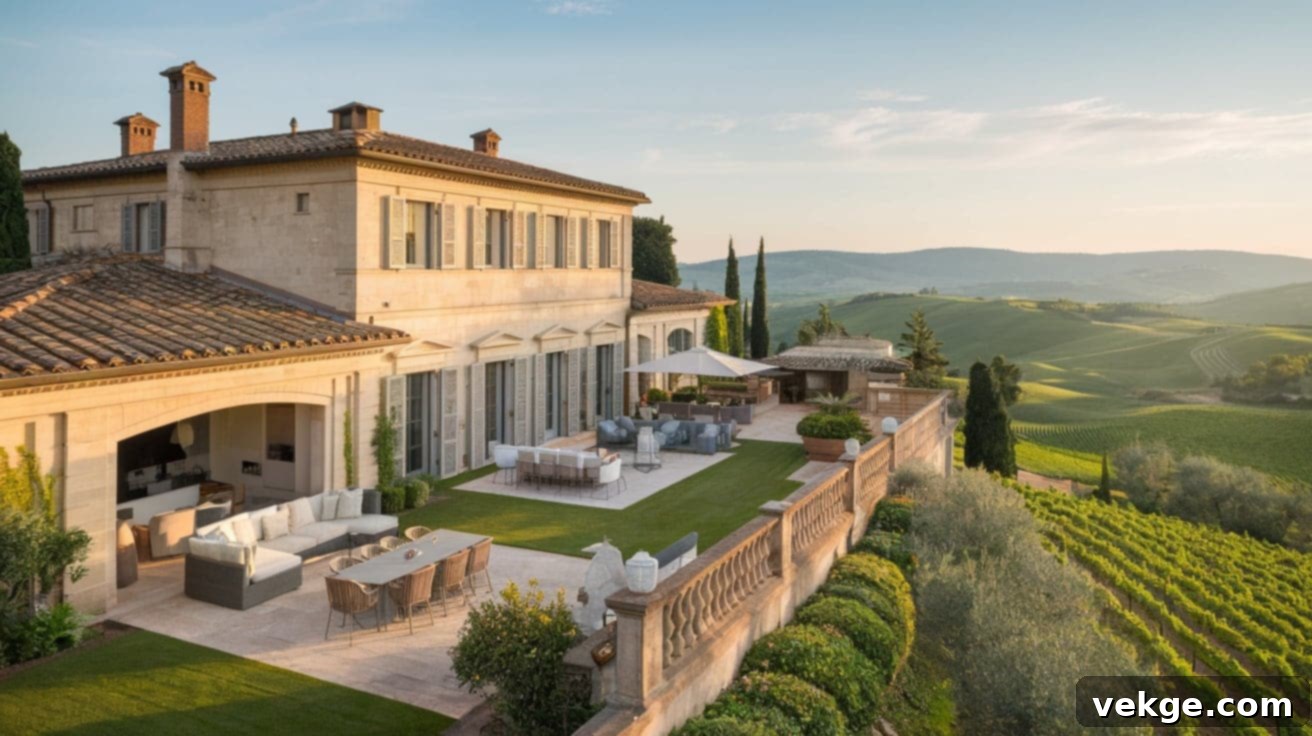Unlocking the Dream: A Comprehensive Guide to Italian Villas, Architecture, and Lifestyle
Imagine waking up to the golden glow of the Tuscan sunrise over rolling hills, or the gentle lapping of waves against the shores of Lake Como. This isn’t just a fantasy; it’s the everyday reality offered by Italian villas. More than just impressive homes, these architectural marvels serve as timeless gateways to a lifestyle steeped in history, natural beauty, and unparalleled comfort, a dream that has captivated hearts for centuries.
From ancient Roman country retreats designed for emperors to the grand estates favored by nobility and modern lakeside havens, Italian villas are unique architectural gems. They masterfully blend centuries of history with breathtaking beauty and contemporary comfort, creating spaces that feel both exquisitely luxurious and warmly inviting. Each villa tells a story, reflecting the rich cultural tapestry of Italy and offering a glimpse into a life of elegance and tranquility.
In this comprehensive guide, we invite you on an inspiring journey through Italy’s most beautiful homes. We’ll explore:
- What truly defines the special character of Italian villas.
- How their unique styles and features vary dramatically across Italy’s diverse regions.
- A curated selection of notable Italian villas that you can visit to experience their grandeur firsthand.
- Essential considerations if you’re dreaming of buying, renovating, or simply appreciating these magnificent properties.
Ready to be inspired by the enduring charm and sophisticated beauty of Italy’s iconic villas? Let’s begin our exploration!
Key Features Defining Italian Villa Architecture and Construction
Italian villas are renowned worldwide for their distinctive aesthetic and structural integrity. While styles may vary regionally, several common architectural elements contribute to their timeless appeal and functionality. Let us take a closer look at some fundamental characteristics you’ll encounter in most Italian villas, showcasing their thoughtful design and enduring craftsmanship.
1. Balanced Layouts and Proportional Harmony
At the heart of Italian villa design lies a profound commitment to symmetry and proportional harmony. Architects and builders have historically adhered to classical principles of geometry, creating layouts where every element feels perfectly placed. This meticulous planning ensures an elegant balance between indoor and outdoor areas, with rooms arranged in a way that fosters a sense of order, sophistication, and seamless flow. Whether it’s the alignment of windows, the placement of grand entrances, or the progression of spaces from formal living areas to private chambers, the design emphasizes a refined artistry that is both aesthetically pleasing and inherently practical.
2. Seamless Integration of Indoor and Outdoor Spaces
A hallmark of Italian villas is their exceptional ability to blur the lines between interior and exterior living. This deliberate integration creates a lifestyle that embraces the magnificent Italian climate and landscape. Features such as spacious loggias (covered outdoor galleries), expansive terraces, and serene courtyards are not mere additions; they are integral parts of the home’s design, providing inviting open-air living spaces. These areas actively encourage relaxation, alfresco dining, and social gatherings, fostering a deeper connection with nature and allowing residents to fully immerse themselves in their picturesque surroundings. This blend is crucial for the Mediterranean lifestyle, maximizing natural light and ventilation.
3. Thoughtful Use of Local, Authentic Materials
Traditional Italian villas are celebrated for their authentic appeal, largely due to the careful utilization of regionally sourced materials. This commitment to local resources not only ensures durability but also harmonizes the structure with its natural environment. Stone, such as travertine or local limestone, terracotta for roofing tiles and flooring, and various types of marble for interior finishes are commonly employed. These natural materials contribute significantly to the villa’s classic beauty and character, aging gracefully over time. Their inherent warmth and texture create an inviting atmosphere, allowing each villa to blend seamlessly with its specific Italian landscape, from the rocky coasts to the fertile valleys.
4. Harmony with the Surrounding Landscape and Environment
Italian villas are masterfully designed to complement, rather than overpower, their natural settings. Their placement is often strategic, carefully chosen to capitalize on the most breathtaking scenic views, whether nestled amidst the rolling Tuscan hills, poised overlooking the shimmering waters of Lake Como, or perched dramatically along the vibrant Amalfi Coast. This thoughtful positioning ensures that the villa becomes an extension of its environment. The integration of lush, meticulously maintained gardens, fragrant olive groves, and productive vineyards further enhances their picturesque charm, creating a cohesive and visually stunning tableau where architecture and nature exist in perfect synergy.
5. Distinctive Structural Elements and Grandeur
Italian villas are characterized by a range of distinct architectural features that collectively contribute to their inherent grandeur and elegant aesthetics. Common elements include graceful arches, robust columns, and impressively high ceilings, all of which lend an air of openness, sophistication, and timeless classicism. These structural components serve more than just artistic purposes; they are also highly functional. For instance, high ceilings improve natural ventilation, keeping interiors cool during warmer months, while large windows and strategically placed arches maximize natural lighting. The result is a home that is not only stylish and stately but also exceptionally comfortable and functional, reflecting centuries of architectural refinement.
Exploring Diverse Italian Villa Types Across Regions
The enchanting variety of Italian villas is a direct reflection of Italy’s diverse geography, climates, and rich local cultures. As you journey across the peninsula, you’ll discover that each region offers a unique architectural interpretation of the villa, deeply rooted in its specific heritage and landscape. From the rustic, earth-toned charm of Tuscan farmhouses to the opulent, classical grandeur of Lake Como estates, each villa type provides a distinct window into Italy’s enduring architectural legacy and way of life.
Tuscany: Countryside Homes with Rustic Charm
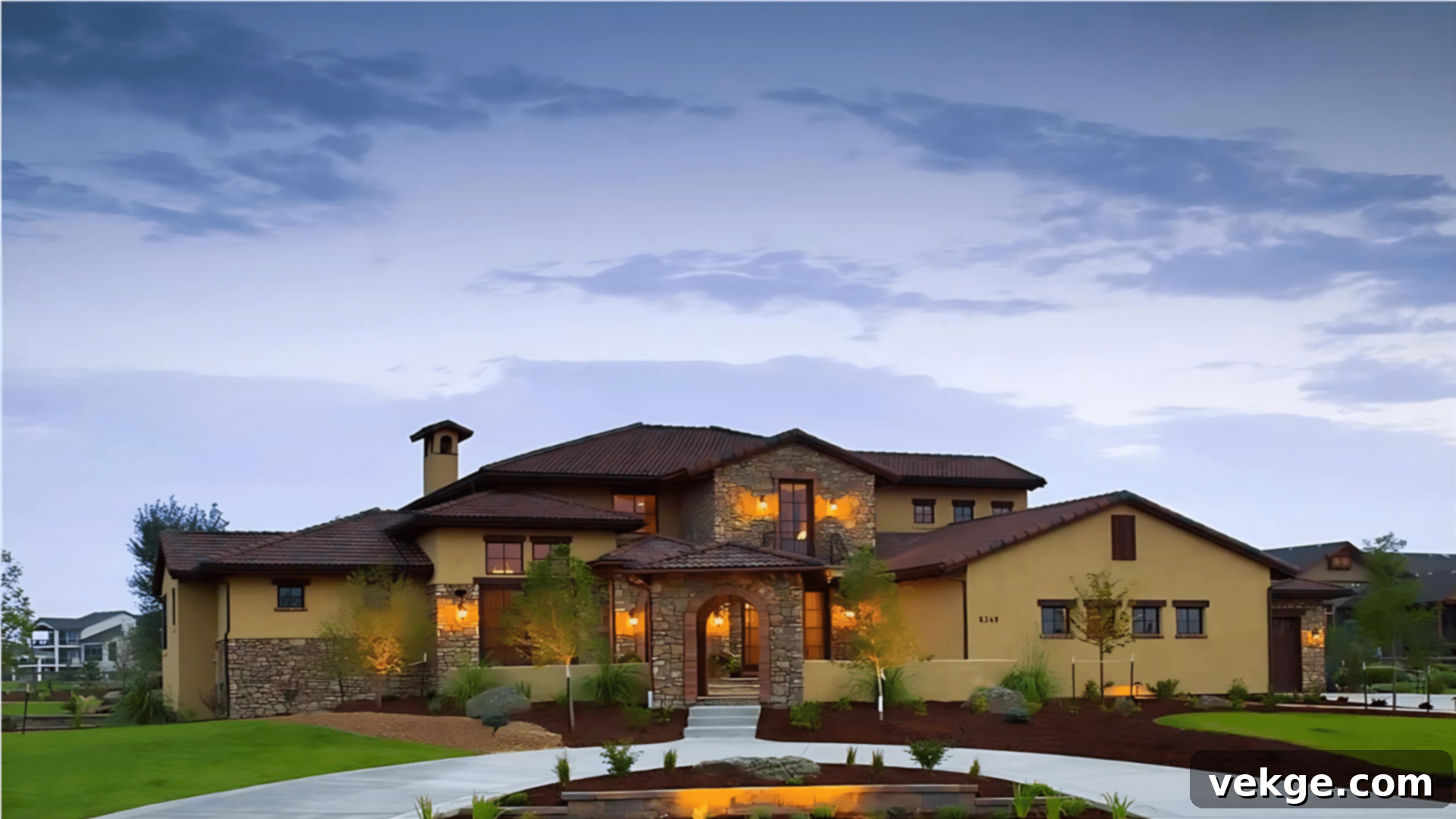
Tuscany, with its iconic rolling hills, cypress-lined drives, and sprawling vineyards, is synonymous with rustic, yet elegant, country villas. These homes are celebrated for their seamless integration with the picturesque landscape. Traditional Tuscan villas are predominantly constructed using warm-toned local stone, featuring distinctive terracotta roofs and often showcasing exposed wooden beams that add to their authentic charm. The architecture emphasizes a connection to the land, often incorporating olive groves and working vineyards into the property. To experience the genuine allure of these rustic homes, a visit to the heart of the Tuscan countryside, perhaps around Siena, Florence, or Chianti, is highly recommended.
Lake Como: Waterfront Properties with Classical Grandeur

The villas gracing the shores of Lake Como are world-renowned for their breathtaking grandeur and exquisite classical design. These magnificent estates typically feature elegant, often ornate, facades and expansive windows meticulously designed to frame the stunning, ever-changing views of the lake and surrounding mountains. Characterized by neoclassical or Baroque influences, many are surrounded by lush, manicured gardens cascading down to the water, often boasting private docks or boathouses. A visit to Lake Como offers a unique opportunity to witness some of Italy’s most opulent waterfront properties, reflecting a history of aristocratic luxury and sophisticated living. Bellagio, Varenna, and Tremezzo are prime locations for this architectural splendor.
Amalfi Coast: Seaside Villas with Vibrant Mediterranean Influences
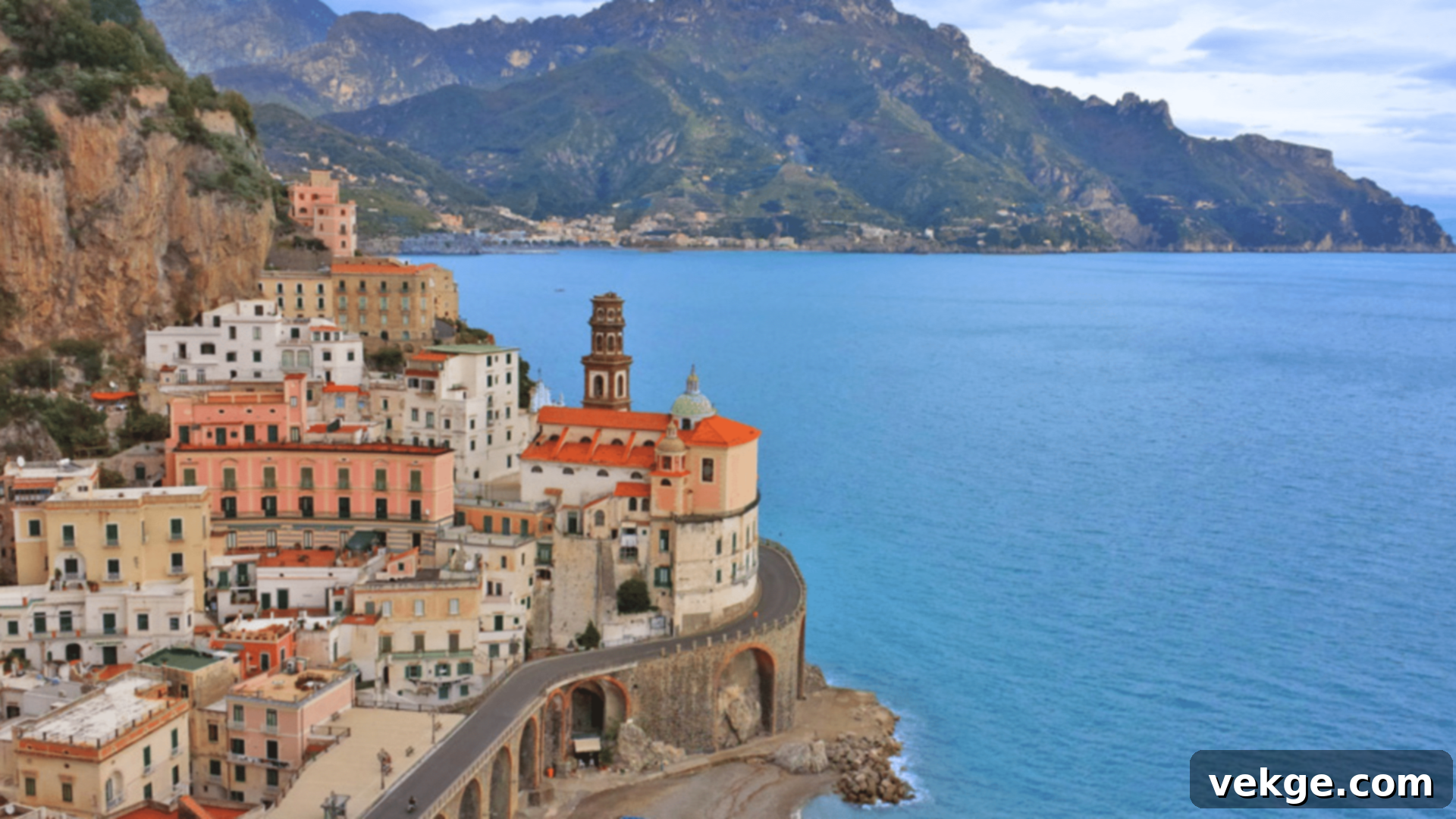
Perched dramatically along the cliffs of the Amalfi Coast, the villas here are a vibrant tapestry of Mediterranean styles. They are typically characterized by their distinctive whitewashed walls, often adorned with colorful ceramic tiles, and expansive terraces that seem to hang over the sparkling turquoise sea. The architecture is ingeniously adapted to the steep, rugged terrain, with multi-tiered gardens and pathways. These seaside villas are designed to maximize the breathtaking coastal views and embrace the sun-soaked climate. Exploring towns like Positano, Ravello, or Amalfi will allow you to discover these picturesque, colorful homes, each offering sweeping panoramas of the Tyrrhenian Sea and a quintessential Mediterranean experience.
Puglia: Traditional Trulli and Masserie Buildings
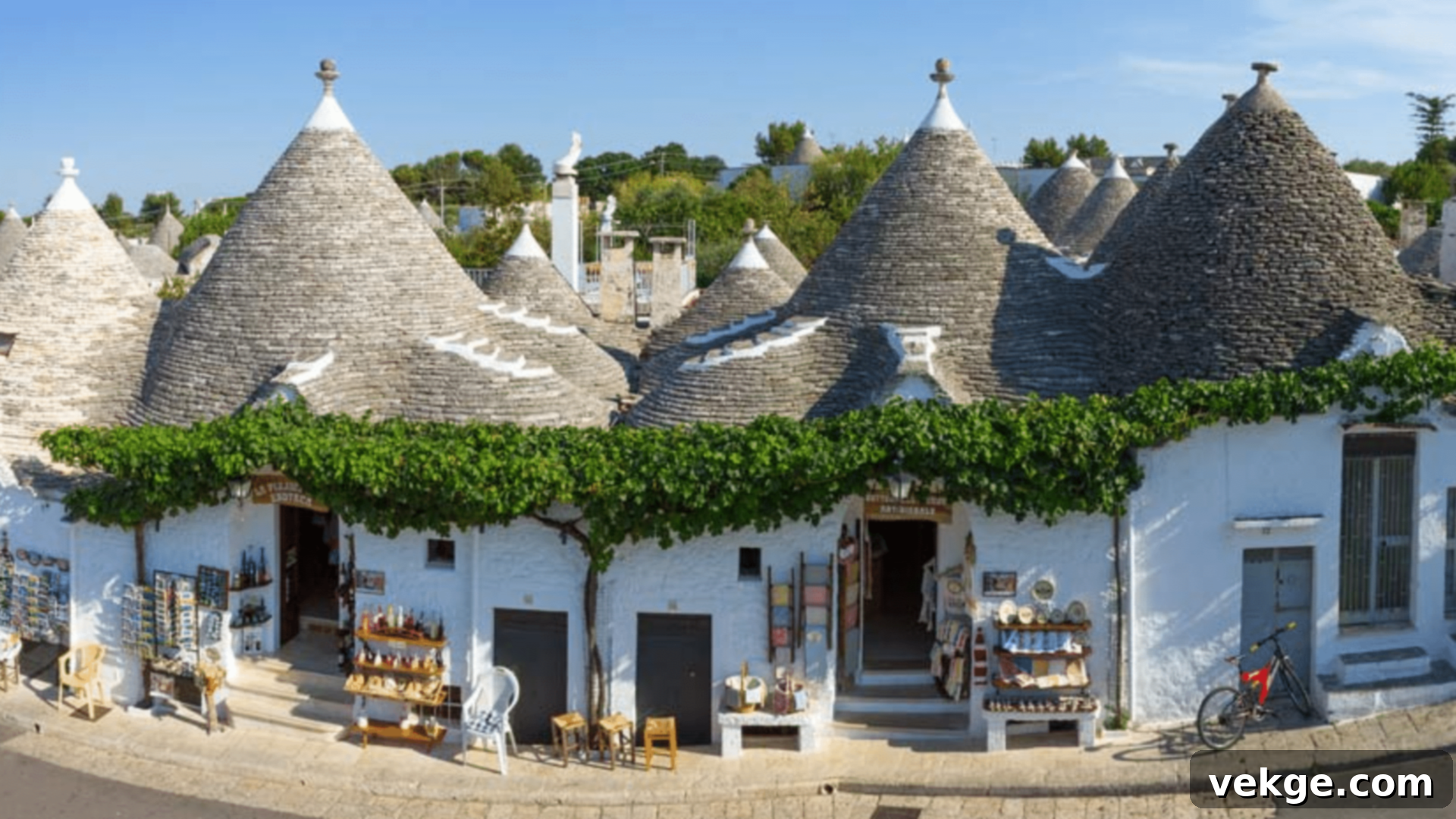
Puglia, located in Italy’s heel, is home to some truly unique architectural marvels: the trulli and masserie. Trulli are small, distinctive stone homes with conical dry-stone roofs, often clustered together, particularly in the Alberobello region (a UNESCO World Heritage site). Masserie, on the other hand, are fortified farmhouses, typically sprawling estates with large courtyards, historically built for agricultural purposes and defense. Both reflect the region’s rich agricultural past and offer a glimpse into a simpler, yet profoundly rooted, way of life. Visiting Puglia provides an unparalleled opportunity to witness these traditional structures, which stand as enduring symbols of the region’s heritage and resourcefulness.
Sicily: Island Homes with Diverse Historical Influences
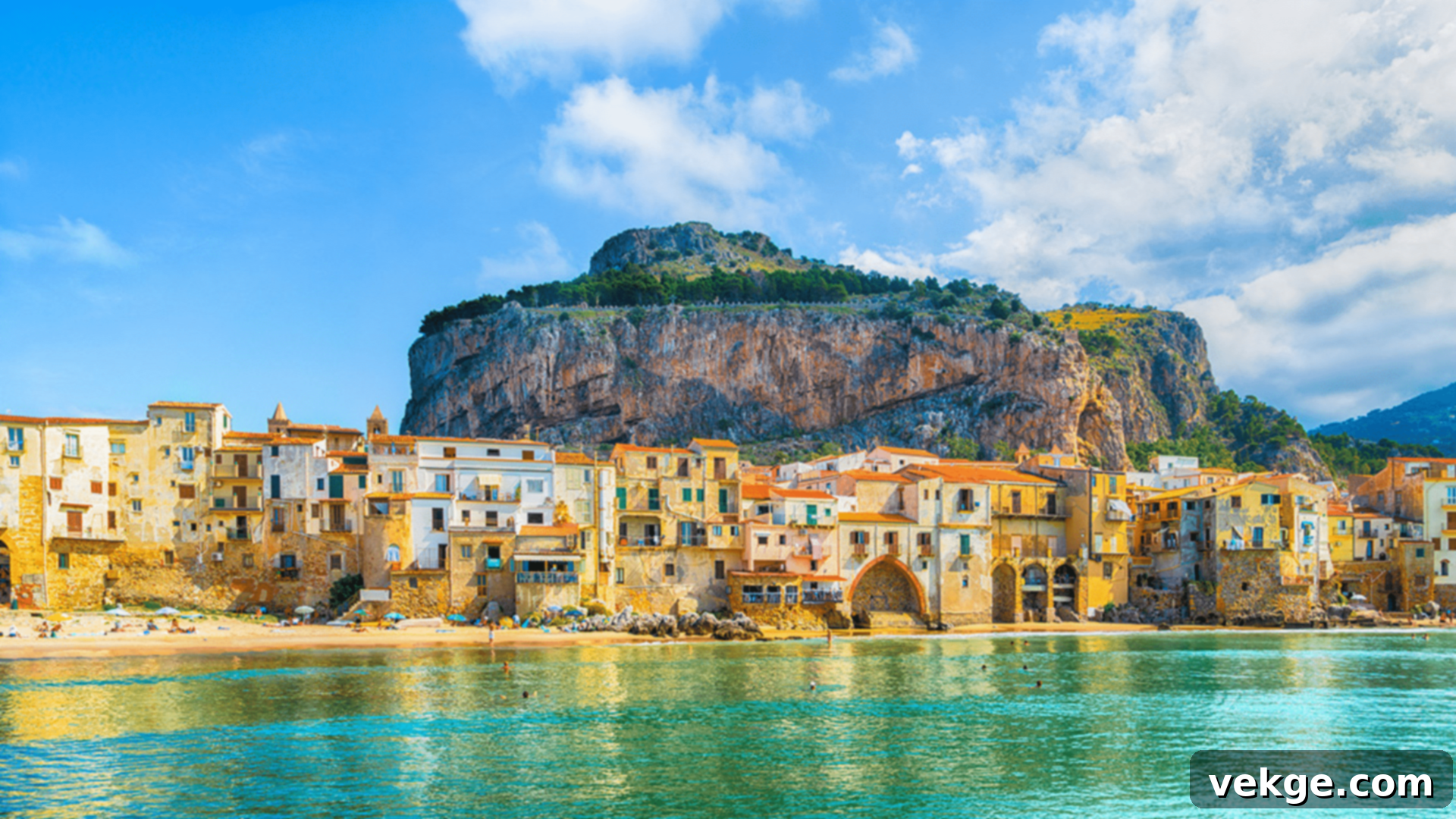
Sicilian villas are a captivating testament to the island’s rich and complex history, showcasing an extraordinary blend of Greek, Roman, Byzantine, Norman, Arab, and Baroque influences. This eclectic heritage manifests in diverse architectural styles, often featuring intricate stone carvings, elegant arched doorways, and vibrant courtyards. These island homes are not just structures; they are living proof of Sicily’s dynamic cultural past, with each element telling a story of conquest, exchange, and artistic fusion. Exploring Sicily, from the bustling streets of Palermo to the serene landscapes around Syracuse, allows you to witness the profound architectural diversity of its villas, shaped by centuries of cross-cultural interaction and artistic innovation.
Inside the Italian Villa: Design & Furnishings for Timeless Elegance
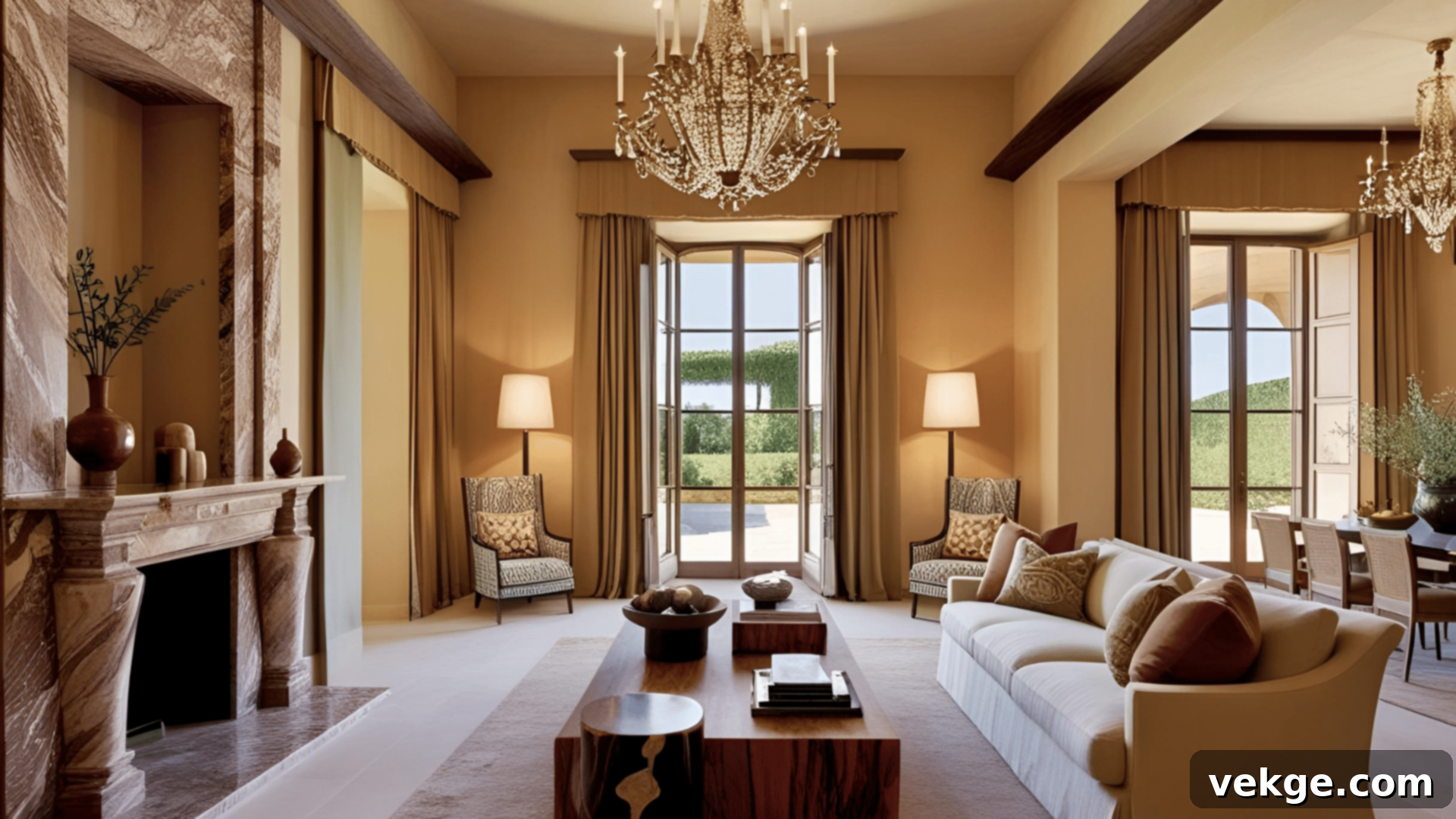
The interiors of Italian villas achieve a masterful balance, seamlessly blending classic charm with contemporary functionality to create an atmosphere of warmth, sophistication, and livability. This careful curation involves the use of rich, tactile materials, exquisitely crafted furniture, and thoughtful design choices that work in harmony. The result is an environment where traditional elegance and modern comfort coexist beautifully, offering spaces that are both visually stunning and inherently welcoming, inviting residents and guests to relax and savor the essence of Italian living.
Color Choices: Earth Tones and Mediterranean Shades
The quintessential color palette found within Italian villas is deeply inspired by the natural beauty of the Italian landscape, both countryside and coast. Earthy tones such as the warm reds of terracotta, rich ochre, and various shades of brown create a grounded and inviting foundation. These are often complemented by refreshing Mediterranean shades like deep blues reminiscent of the sea, and tranquil greens found in olive groves and vineyards. This naturalistic approach to color choice creates a soothing and classic atmosphere indoors, reflecting the serene beauty outside the villa’s walls and enhancing the sense of harmony with nature.
Notable Italian Furniture Makers and Brands
Italy is globally celebrated as a powerhouse of design and craftsmanship, and its furniture brands exemplify this reputation. Names like Boffi, known for its sleek kitchens and bathrooms; B&B Italia, a leader in contemporary design; and Knoll, with its blend of modernism and classic pieces, are renowned worldwide. These companies boast a rich history of marrying traditional Italian artisan techniques with groundbreaking design innovation. They offer a diverse range of luxurious yet highly functional furniture that impeccably complements the inherent elegance of a villa, ensuring interiors are both stylish and practical, making Italian design a benchmark for quality and sophistication.
Blending Traditional and Modern Design Elements
A defining characteristic of contemporary Italian villa interiors is their remarkable ability to seamlessly blend cherished traditional elements with sleek modern design. This fusion creates spaces that honor the past while embracing the present. You’ll often find classic features such as exquisitely handcrafted wooden furniture, ornate chandeliers, and even preserved frescoed ceilings artfully juxtaposed with minimalist, contemporary furnishings, cutting-edge appliances, and clean-lined aesthetics. This thoughtful combination successfully preserves the villa’s profound historical charm and architectural heritage while effortlessly meeting the demands and comfort standards of modern living, creating a truly unique and harmonious environment.
Materials: Wood, Marble, Ceramics, and Textiles
The selection of materials in Italian villa interiors is a deliberate process, meticulously chosen to enhance both aesthetic appeal and practical functionality. Dominant materials include various types of wood (often rich walnut or oak), luxurious marble (such as Carrara, Calacatta, or Travertine), exquisite ceramics (from intricate mosaic tiles to polished flooring), and fine textiles (like linen, silk, and cotton). Marble floors and countertops add a touch of grandeur and coolness, wooden furniture brings warmth and tradition, and ceramic tiles introduce vibrant patterns and texture. These materials are frequently sourced locally, further emphasizing the regional character and authenticity of the home, creating a tactile and visually rich interior landscape.
Lighting Design for an Authentic Italian Villa Atmosphere
Lighting plays an absolutely crucial role in defining the authentic atmosphere of an Italian villa. The design thoughtfully emphasizes both the grandeur and the inherent warmth of these homes. From majestic chandeliers that serve as focal points in grand living rooms and dining areas to the soft, ambient lighting that transforms courtyards and terraces into magical evening retreats, every fixture is carefully selected. Maximizing natural light is paramount, achieved through large, strategically placed windows, French doors, and open architectural spaces that flood interiors with sunlight during the day. As evening descends, well-placed artificial lighting adds layers of elegance, highlights architectural features, and creates an intimate, inviting glow, completing the quintessential Italian villa experience.
Modern Comforts Integrated into Today’s Italian Villas
While steeped in history and tradition, Italian villas in the modern era masterfully integrate cutting-edge luxury with contemporary conveniences, offering a sophisticated blend of past and present. These thoughtful additions ensure that the timeless charm of Italian design is complemented by the highest standards of modern living, providing an experience that is both authentic and exceptionally comfortable. The focus is on enhancing the lifestyle, bringing innovative features discreetly into historic or newly built structures.
-
Infinity Pools with Panoramic Views: A signature feature of many modern Italian villas, infinity pools offer more than just a place to swim. Designed to visually merge with the horizon, they create a breathtaking illusion of endless water, particularly when overlooking rolling hills, a sparkling lake, or the azure sea. These pools elevate outdoor living spaces to a whole new level, providing a tranquil and luxurious retreat perfect for relaxation, exercise, and enjoying unparalleled vistas.
-
Wine Storage and Tasting Areas: Reflecting Italy’s profound and rich winemaking culture, many contemporary villas incorporate purpose-built wine cellars and dedicated tasting rooms. These sophisticated spaces are meticulously designed to store fine wine collections at optimal conditions, often featuring climate control and elegant displays. They offer a perfect setting for connoisseurs to savor exquisite selections, entertain guests, and celebrate the deep-rooted Italian tradition of viticulture within the comfort of their own home.
-
Outdoor Kitchens and Dining Spaces: Embracing the beloved Italian lifestyle of “al fresco” dining, modern villas frequently feature fully equipped outdoor kitchens and expansive dining areas. These spaces are designed for seamless entertaining and enjoyment of meals under the open sky, often complemented by scenic gardens, pergolas, or spacious terraces. Complete with built-in grills, pizza ovens, refrigerators, and ample counter space, they make preparing and enjoying delicious Italian food outdoors an effortless and joyful experience.
-
Wellness Features (Spas, Saunas, Exercise Rooms): Prioritizing health and relaxation, many modern Italian villas now incorporate luxurious wellness areas. These may include private spas with hydromassage tubs, soothing saunas, and fully equipped home gyms. These dedicated spaces offer residents the convenience and privacy to engage in their health routines, unwind, and rejuvenate without leaving the comfort and serenity of their villa, further enhancing the overall sense of luxury and well-being.
-
Integrating Modern Technology into Historic Villas: One of the most impressive feats in contemporary villa design is the discreet integration of modern technology into historic structures. Smart home systems, advanced climate control, state-of-the-art entertainment systems, and sophisticated security solutions are seamlessly woven into the villa’s fabric. This ensures optimal comfort, efficiency, and functionality without ever detracting from the architectural heritage or classic aesthetic, demonstrating a masterful blend of old-world charm with cutting-edge convenience.
Notable Italian Villas to Visit and Admire
For those eager to experience the grandeur and architectural beauty firsthand, Italy offers a wealth of incredible villas open to the public. These notable Italian villas provide a captivating glimpse into the country’s rich history, diverse architectural styles, and breathtaking scenic landscapes. Each villa possesses its unique charm and story, reflecting different periods of Italian design and the lives of those who inhabited them.
Villa d’Este (Tivoli, Lazio)
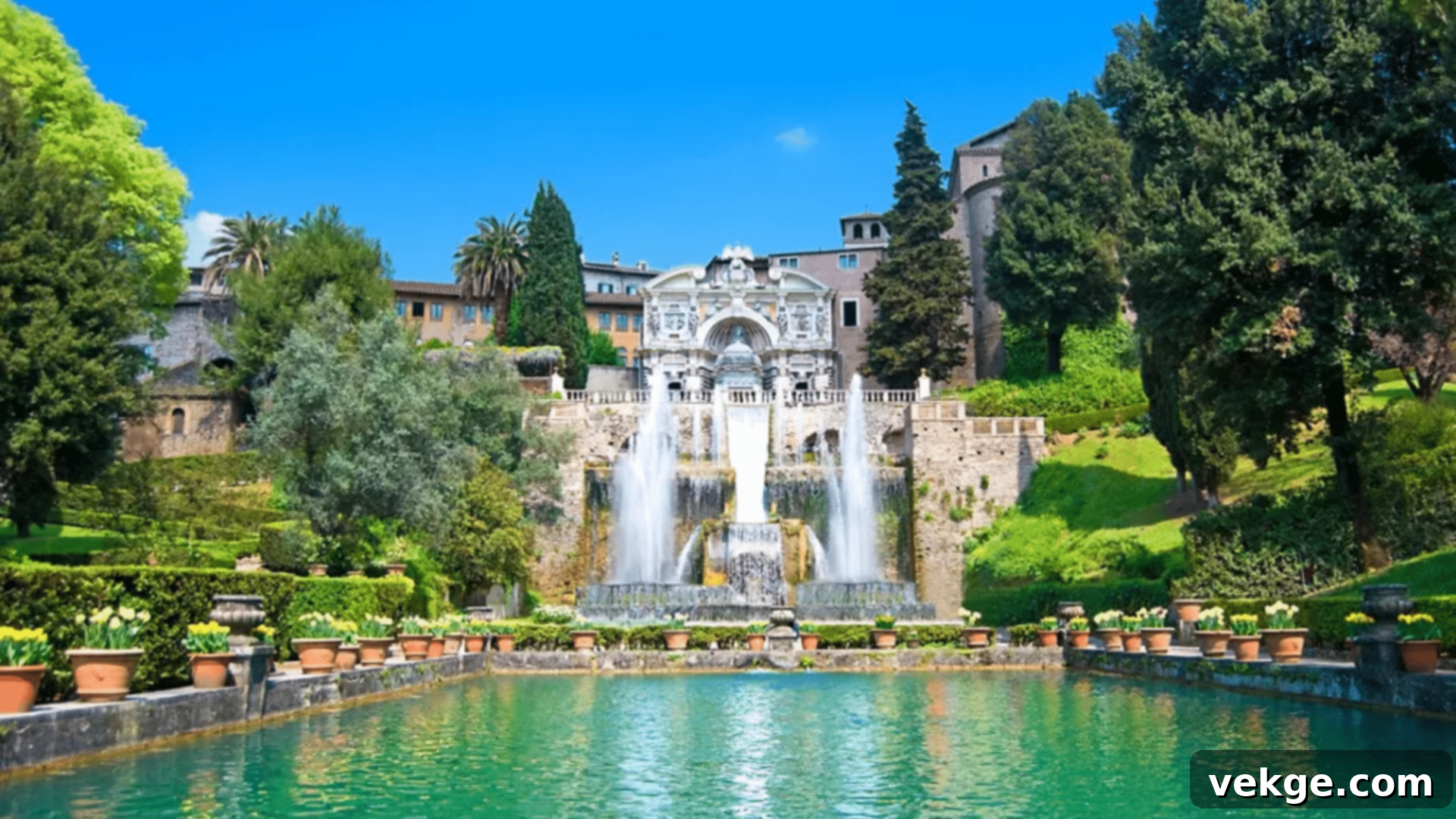
A UNESCO World Heritage site, Villa d’Este in Tivoli is perhaps the most famous example of Italian Renaissance garden design. Built in the 16th century for Cardinal Ippolito II d’Este, it is celebrated for its extraordinary and elaborate fountains, grottoes, and nymphaeums, all powered by hydraulic engineering that was groundbreaking for its time. The villa’s grand architecture is harmoniously intertwined with its magnificent terraced gardens, creating an awe-inspiring spectacle of water features, lush greenery, and intricate sculptures. A visit to Villa d’Este offers an unforgettable experience of Renaissance splendor and ingenuity, showcasing one of Italy’s most celebrated historical villas.
Villa Balbiano (Lake Como, Lombardy)

Nestled on the serene western shores of Lake Como, Villa Balbiano stands as a true masterpiece of classical architecture and opulent design. Originally built in the 17th century by Cardinal Durini, this grand estate boasts sumptuous interiors adorned with original frescoes and exquisite antique furnishings, reflecting centuries of aristocratic luxury. Its expansive, meticulously maintained gardens, with direct lake access and panoramic views, contribute to its status as one of Lake Como’s most prestigious properties. Villa Balbiano has gained significant international recognition, serving as a sought-after location for high-profile films and exclusive events, solidifying its place as an icon of Italian elegance.
Villa Lissoni (Lake Como, Lombardy)

Designed by the celebrated contemporary architect Piero Lissoni, this villa on Lake Como embodies a perfect synthesis of historic charm and modern minimalist elegance. Villa Lissoni represents a thoughtful renovation project, where traditional Italian architectural elements are meticulously preserved and honored, while seamlessly introducing contemporary design principles. The interiors feature clean lines, open-plan spaces, and a subdued color palette, all designed to maximize natural light and draw the breathtaking beauty of the lake directly into the living environment. It’s an outstanding example of how innovative design can refresh a historic property, creating a luxurious and harmonious dialogue between the past and the present.
Villa Oleandra (Lake Como, Lombardy)
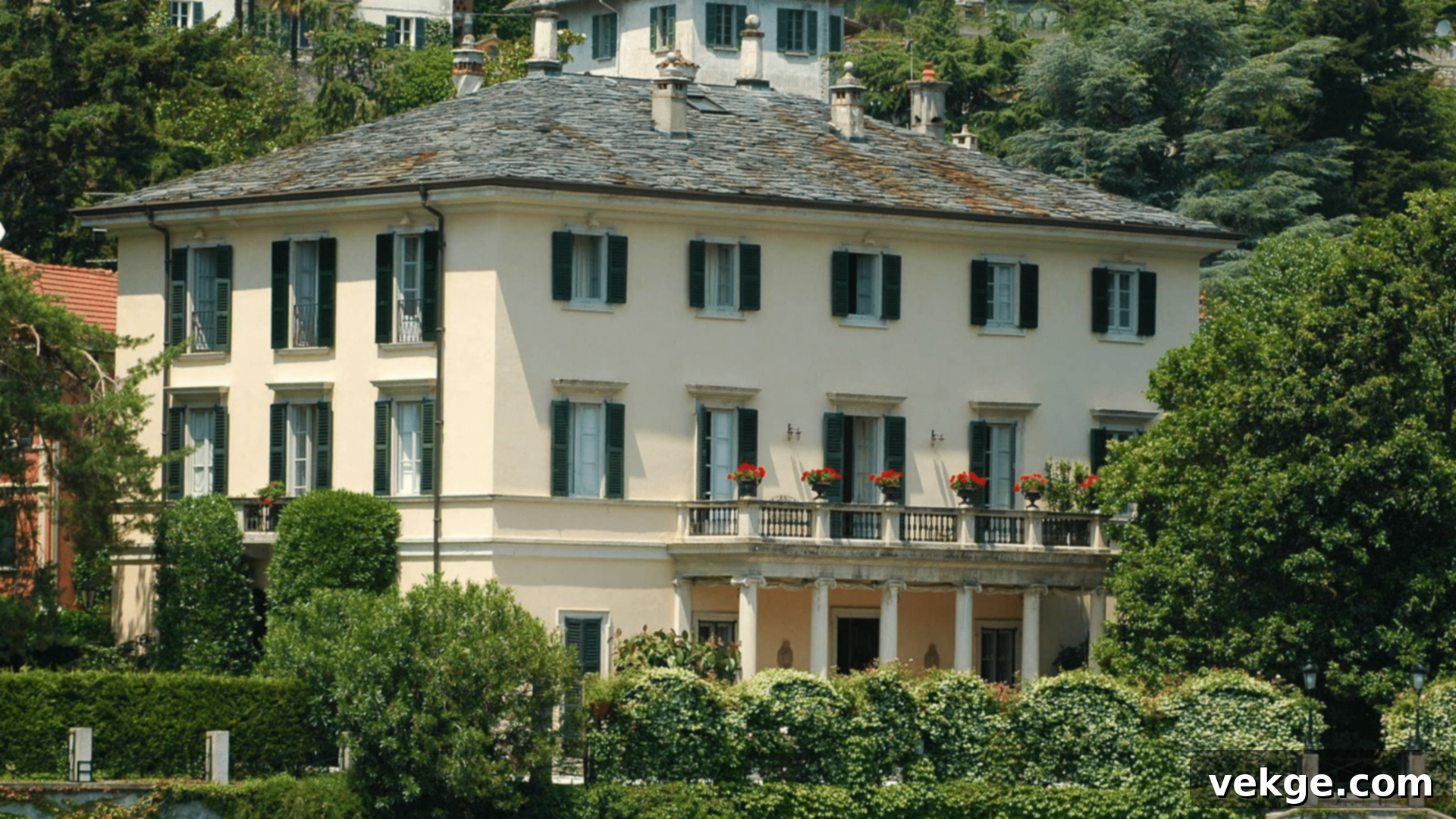
Perhaps one of Italy’s most recognized private residences, Villa Oleandra on Lake Como gained international fame as the cherished retreat of Hollywood star George Clooney. This luxurious 18th-century estate is a prime example of Lake Como’s allure, featuring grand terraces that offer unparalleled lake views, lush private gardens, and an air of secluded sophistication. Its frequent appearances in celebrity news and media have transformed it into a symbol of aspirational luxury and the glamorous Italian lifestyle. While not publicly accessible, its prominence has drawn countless visitors to the region, eager to catch a glimpse of this iconic villa and immerse themselves in the celebrity-favored charm of Lake Como.
Villa Treviso (Treviso, Veneto)

Villa Treviso stands as a striking example of modern architectural innovation seamlessly blended with revered Italian tradition, particularly within the Veneto region. This villa is a beacon of sustainable design, featuring energy-efficient materials, advanced smart home technology, and eco-friendly landscaping solutions that minimize environmental impact. Its design thoughtfully incorporates large windows and open spaces that invite natural light and connect residents with the surrounding landscape, echoing the classic principles of harmony with nature. Villa Treviso exemplifies how contemporary design can not only respect Italy’s timeless aesthetic but also push the boundaries of sustainable luxury, offering a vision for the future of Italian villa living.
Practical Tips for Italian Villa Owners or Renters
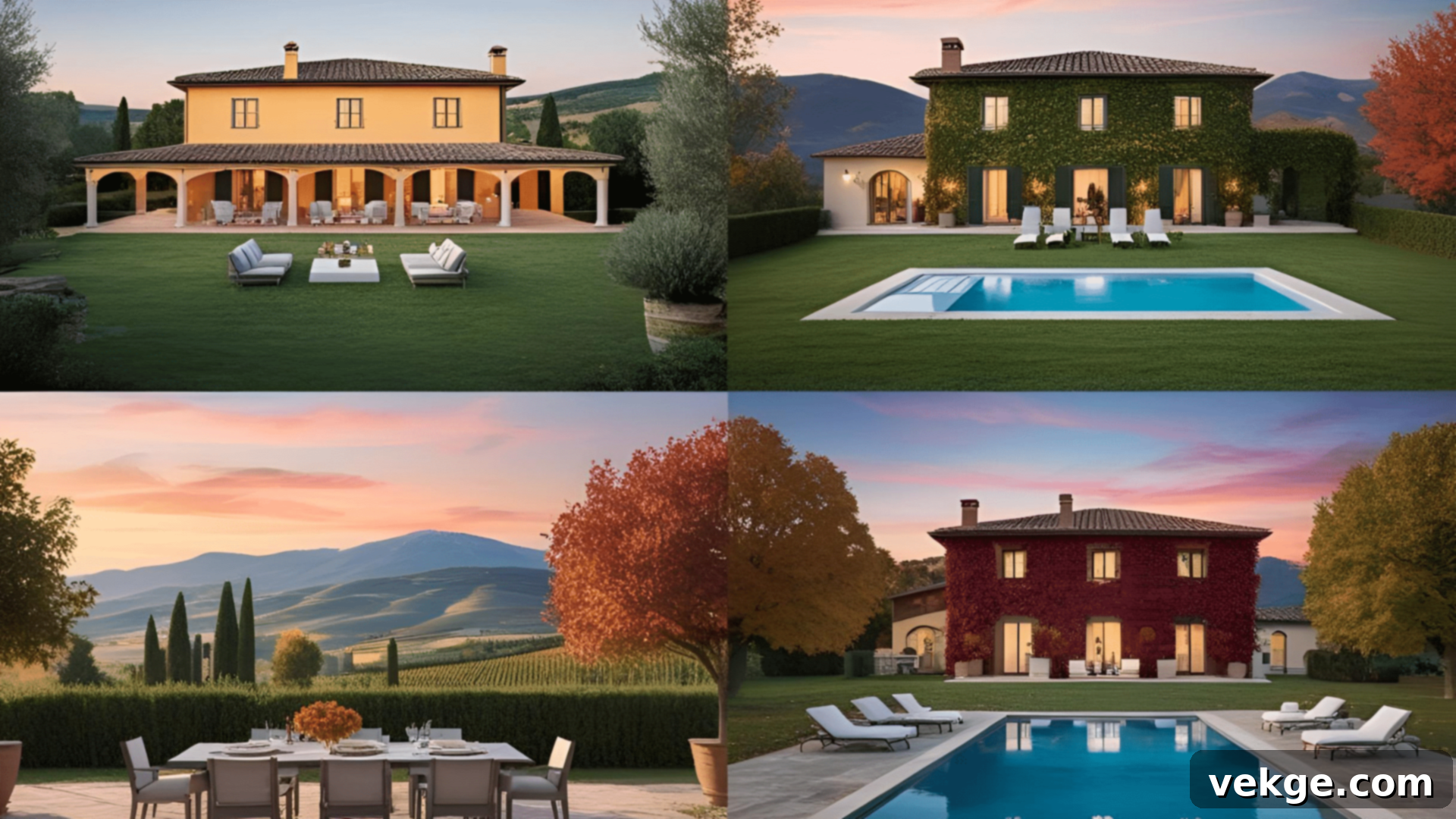
Embracing the dream of living in an Italian villa, whether as an owner or a long-term renter, is a wonderfully rewarding experience, yet it comes with its unique set of considerations. These magnificent properties, often steeped in history, require thoughtful care and a keen understanding of local customs. Here’s what you need to know to ensure a smooth and enjoyable experience, allowing you to truly make the most of your time in these beautiful Italian homes.
Seasonal Considerations for Villa Living
Life in an Italian villa transforms with the rhythms of each season, offering distinct pleasures and requiring different preparations:
- Summer: This is the quintessential time for outdoor living. Prepare to maximize enjoyment of infinity pools, lush gardens, and shaded loggias, perfect for leisurely alfresco dining under the warm Italian sun. Ensure outdoor furnishings are comfortable and protection from the sun is available.
- Fall: As temperatures cool, embrace the vibrant cultural activities associated with harvest season. Participate in grape or olive harvests, attend local festivals, and savor the changing, golden landscapes. Consider wood-burning fireplaces for cozy evenings.
- Winter: Older stone villas can get quite chilly. It’s crucial to ensure the property has adequate and efficient heating systems. Many historic homes might rely on fireplaces or less modern heating, so understanding and preparing for this is key to comfort.
- Spring: Witness the spectacular awakening of nature. Gardens burst into bloom, and the air is fresh and invigorating. This is an ideal time for long walks, open windows, and enjoying the villa’s natural surroundings without the summer heat.
Essential Maintenance for Historic Properties
Caring for an Italian villa, especially an older one, demands regular attention and a proactive approach. These properties are built to last but require specific maintenance to preserve their integrity and charm:
- Regular and thorough inspection of terracotta tile roofs and ancient stone walls is vital to identify and address any needed repairs promptly, preventing larger issues like leaks or structural damage.
- Periodic treatment of exposed wooden beams and antique furniture is necessary to protect against insects, wood rot, and humidity damage, preserving their historical value and structural role.
- Older villas often have antiquated plumbing and electrical systems. Budget for necessary updates or be aware of their limitations to ensure safety and modern functionality.
- Consistent garden and landscape maintenance is paramount, not just for aesthetics but also to manage irrigation, preserve historic plantings, and prevent overgrowth that could affect the structure.
- It’s wise to budget approximately 1-2% of the property’s value annually for maintenance costs, as historic properties can sometimes incur unexpected expenses due to their age and unique construction.
Working Effectively with Local Expertise and Culture
Navigating local work customs and finding reliable professionals in Italy can be different from what you’re accustomed to. A little patience and cultural understanding go a long way:
- Be mindful of local holidays, afternoon siestas (known as riposo), and payment expectations, which might differ from your home country. Building good relationships with local service providers is invaluable.
- Cultivate connections with local gardeners (giardinieri) who possess an innate knowledge of indigenous Italian plants, traditional growing methods, and the specific needs of your villa’s landscape. Their expertise is irreplaceable.
- Seek out house cleaners and domestic staff who have experience working with older properties and are skilled in the delicate care of antique furnishings, fabrics, and specialized surfaces.
- Establish relationships with trusted local plumbers (idraulici) and electricians (elettricisti) who have a deep understanding of older building infrastructures and can troubleshoot issues unique to historic Italian homes.
- Consider learning basic Italian phrases. Even a little effort to communicate in the local language can significantly enhance your interactions and facilitate stronger relationships with your local community and service providers.
Conclusion: The Enduring Allure of Italian Villas
Italian villas stand as timeless testaments to a classic blend of history, exquisite architecture, and unparalleled natural beauty. They offer more than just a place to live; they present an entire lifestyle, deeply rooted in Italian culture and celebrated worldwide. From the majestic grandeur of historic estates like Villa d’Este, a UNESCO World Heritage site, to innovative contemporary renovations that respectfully honor tradition while embracing modern comforts, these homes beautifully reflect Italy’s profound cultural heritage and its continuous evolution.
Whether you’re drawn to public landmarks that whisper tales of bygone eras, intrigued by celebrity-owned retreats that epitomize luxury, or inspired by sustainable new designs that forge a path to the future, each Italian villa tells a unique and captivating story. Their interiors are a masterclass in design, seamlessly blending classic beauty with modern functionality, making them both visually striking and incredibly comfortable for modern living. The thoughtful integration of local materials, harmonious color palettes, and sophisticated lighting further enhances their distinctive charm.
Experiencing these magnificent villas, whether through a visit, a stay, or by dreaming of ownership, offers a profound and deeper appreciation of Italian design, artistry, and the coveted Italian lifestyle. They leave an indelible impression on anyone who is drawn to the country’s rich history, its celebrated art, and its enduring architectural magnificence. An Italian villa is truly a dream made tangible, an invitation to live amidst beauty and tradition.
